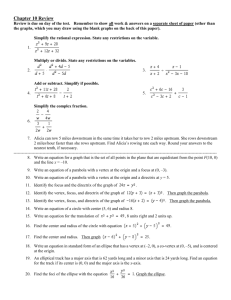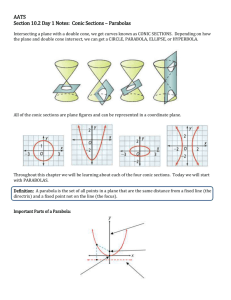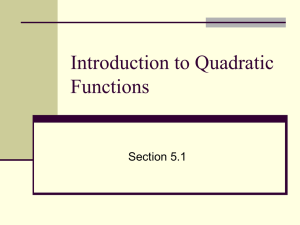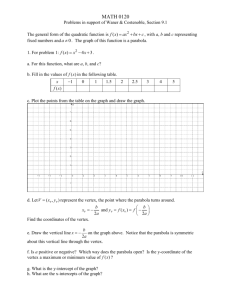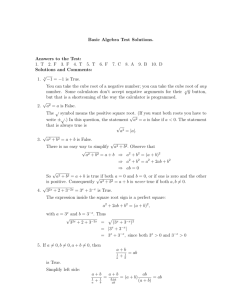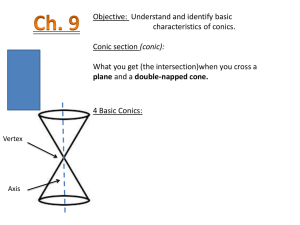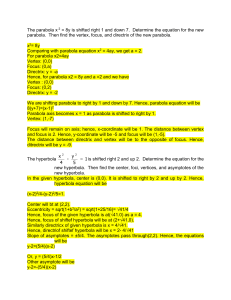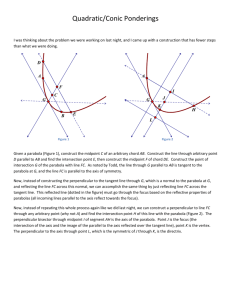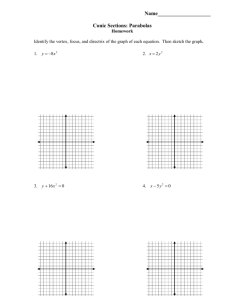Study Guide and Review
advertisement
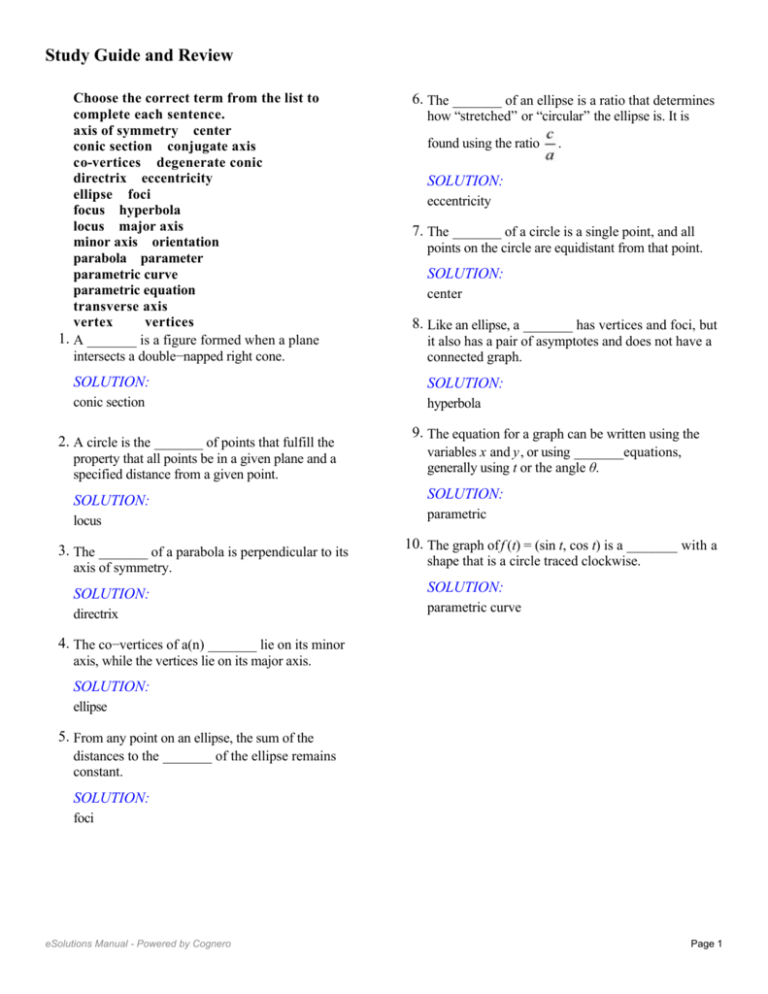
distances to the _______ of the ellipse remains constant. Study Guide and Review Choose the correct term from the list to complete each sentence. axis of symmetry center conic section conjugate axis co-vertices degenerate conic directrix eccentricity ellipse foci focus hyperbola locus major axis minor axis orientation parabola parameter parametric curve parametric equation transverse axis vertex vertices 1. A _______ is a figure formed when a plane intersects a double−napped right cone. SOLUTION: foci 6. The _______ of an ellipse is a ratio that determines how “stretched” or “circular” the ellipse is. It is found using the ratio SOLUTION: eccentricity 7. The _______ of a circle is a single point, and all points on the circle are equidistant from that point. SOLUTION: center 8. Like an ellipse, a _______ has vertices and foci, but it also has a pair of asymptotes and does not have a connected graph. SOLUTION: SOLUTION: conic section hyperbola 2. A circle is the _______ of points that fulfill the . 9. The equation for a graph can be written using the property that all points be in a given plane and a specified distance from a given point. variables x and y, or using _______equations, generally using t or the angle θ. SOLUTION: SOLUTION: locus parametric 3. The _______ of a parabola is perpendicular to its 10. The graph of f (t) = (sin t, cos t) is a _______ with a axis of symmetry. shape that is a circle traced clockwise. SOLUTION: SOLUTION: directrix parametric curve 4. The co−vertices of a(n) _______ lie on its minor axis, while the vertices lie on its major axis. 11. (x + 3)2 = 12(y + 2) SOLUTION: ellipse SOLUTION: 5. From any point on an ellipse, the sum of the distances to the _______ of the ellipse remains constant. SOLUTION: 2 (x + 3) = 12(y + 2) The equation is in standard form and the squared term is x, which means that the parabola opens 2 foci 6. The _______ of an ellipse is a ratio that determines how “stretched” or “circular” the ellipse is. It is found using the ratio For each equation, identify the vertex, focus, axis of symmetry, and directrix. Then graph the parabola. . vertically. The equation is in the form (x − h) = 4p (y − k), so h = −3 and k = −2. Because 4p = 12 and p = 3, the graph opens up. Use the values of h, k, and p to determine the characteristics of the parabola. vertex: (−3, −2) directrix: y = −5 focus: (−3, 1) axis of symmetry: x = −3 SOLUTION: eSolutions Manual - Powered by Cognero eccentricity 7. The _______ of a circle is a single point, and all (h, k) y = k –p (h, k + p ) x=h Page 1 10. The graph of f (t) = (sin t, cos t) is a _______ with a shape that is a circle traced clockwise. SOLUTION: Study Guide and Review parametric curve For each equation, identify the vertex, focus, axis of symmetry, and directrix. Then graph the parabola. 2 12. (y – 2)2 = 8(x – 5) SOLUTION: 2 11. (x + 3) = 12(y + 2) SOLUTION: 2 (x + 3) = 12(y + 2) The equation is in standard form and the squared term is x, which means that the parabola opens 2 vertically. The equation is in the form (x − h) = 4p (y − k), so h = −3 and k = −2. Because 4p = 12 and p = 3, the graph opens up. Use the values of h, k, and p to determine the characteristics of the parabola. (y – 2) = 8(x – 5) The equation is in standard form and the squared term is y, which means that the parabola opens 2 horizontally. The equation is in the form (y − k) = 4p (x − h), so h = 5 and k = 2. Because 4p = 8 and p = 2, the graph opens to the right. Use the values of h, k, and p to determine the characteristics of the parabola. vertex: (5, 2) directrix: x = 3 focus: (7, 2) axis of symmetry: y = 2 vertex: (−3, −2) directrix: y = −5 focus: (−3, 1) axis of symmetry: x = −3 (h, k) y = k –p (h, k + p ) x=h (h, k) x = h –p (h + p , k) y =k Graph the vertex, focus, axis, and directrix of the parabola. Then make a table of values to graph the general shape of the curve. Graph the vertex, focus, axis, and directrix of the parabola. Then make a table of values to graph the general shape of the curve. 13. (x – 2)2 = –4(y + 1) SOLUTION: 2 (x – 2) = −4(y + 1) The equation is in standard form and the squared term is x, which means that the parabola opens 12. (y – 2)2 = 8(x – 5) 2 SOLUTION: 2 (y – 2) = 8(x – 5) The equation is in standard form and the squared term is y, which means that the parabola opens 2 horizontally. The equation is in the form (y − k) = 4p (x − h), so h = 5 and k = 2. Because 4p = 8 and p = 2, the graph opens to the right. Use the values of h, k, and p to determine the characteristics of the parabola. vertex: (5, 2) directrix: x = 3 focus: (7, 2) axis of symmetry: y = 2 (h, k) x = h –p (h + p , k) y =k Manual - Powered by Cognero eSolutions Graph the vertex, focus, axis, and directrix of the parabola. Then make a table of values to graph the vertically. The equation is in the form (x − h) = 4p (y − k), so h = 2 and k = −1. Because 4p = −4 and p = −1, the graph opens down. Use the values of h, k, and p to determine the characteristics of the parabola. vertex: (2, −1) directrix: y = 0 focus: (2, −2) axis of symmetry: x = 2 (h, k) y = k –p (h, k + p ) x=h Graph the vertex, focus, axis, and directrix of the parabola. Then make a table of values to graph the general shape of the curve. Page 2 Study Guide and Review 13. (x – 2)2 = –4(y + 1) 14. (x – 5) = 2 (y – 3) SOLUTION: 2 (x – 2) = −4(y + 1) The equation is in standard form and the squared term is x, which means that the parabola opens 2 vertically. The equation is in the form (x − h) = 4p (y − k), so h = 2 and k = −1. Because 4p = −4 and p = −1, the graph opens down. Use the values of h, k, and p to determine the characteristics of the parabola. SOLUTION: (x – 5) = 2 (y – 3) The equation is in standard form and the squared term is y, which means that the parabola opens 2 horizontally. The equation is in the form (y − k) = 4p (x − h), so h = 5 and k = 3. Because 4p = and vertex: (2, −1) directrix: y = 0 focus: (2, −2) axis of symmetry: x = 2 p= (h, k) y = k –p (h, k + p ) x=h , the graph opens to the right. Use the values of h, k, and p to determine the characteristics of the parabola. Graph the vertex, focus, axis, and directrix of the parabola. Then make a table of values to graph the general shape of the curve. vertex: (5, 3) (h, k) directrix: x = 2 x = h –p focus: (h + p , k) axis of symmetry: y = 3 y =k Graph the vertex, focus, axis, and directrix of the parabola. Then make a table of values to graph the general shape of the curve. 14. (x – 5) = 2 (y – 3) SOLUTION: (x – 5) = 2 (y – 3) The equation is in standard form and the squared term is y, which means that the parabola opens 2 horizontally. The equation is in the form (y − k) = 4p (x − h), so h = 5 and k = 3. Because 4p = p= and , the graph opens to the right. Use the values of h, k, and p to determine the characteristics of the parabola. vertex: (5, 3) (h, k) directrix: x = 2 x = h –p eSolutions Manual - Powered by Cognero focus: axis of symmetry: y = 3 (h + p , k) y =k Write an equation for and graph a parabola with the given focus F and vertex V. 15. F(1, 1), V(1, 5) SOLUTION: Because the focus and vertex share the same xcoordinate, the graph is vertical. The focus is (h, k + p), so the value of p is 1 − 5 or −4. Because p is negative, the graph opens down. Write the equation for the parabola in standard form using the values of h, p , and k. 4p (y – k) = (x – h)2 4(−4)(y – 5) = (x – 1)2 Page 3 −16(y − 5) = (x − 1)2 2 The standard form of the equation is (x – 1) = −16 (y – 5). Study Guide and Review Write an equation for and graph a parabola with the given focus F and vertex V. 15. F(1, 1), V(1, 5) SOLUTION: Because the focus and vertex share the same xcoordinate, the graph is vertical. The focus is (h, k + p), so the value of p is 1 − 5 or −4. Because p is negative, the graph opens down. Write the equation for the parabola in standard form using the values of h, p , and k. 4p (y – k) = (x – h)2 4(−4)(y – 5) = (x – 1)2 −16(y − 5) = (x − 1)2 2 The standard form of the equation is (x – 1) = −16 (y – 5). Graph the vertex and focus. Then make a table of values to graph the parabola. 16. F(–3, 6), V(7, 6) SOLUTION: Because the focus and vertex share the same ycoordinate, the graph is horizontal. The focus is (h + p, k), so the value of p is −3 − 7 or −10. Because p is negative, the graph opens to the left. Write the equation for the parabola in standard form using the values of h, p , and k. 2 (y – h) = 4p (x – k) 2 (y − 6) = 4(−10)(x − 7) 2 (y − 6) = −40(x − 7) 2 The standard form of the equation is (y – 6) = −40 (x – 7). Graph the vertex and focus. Then make a table of values to graph the parabola. 17. F(–2, –3), V(–2, 1) SOLUTION: 16. F(–3, 6), V(7, 6) SOLUTION: Because the focus and vertex share the same ycoordinate, the graph is horizontal. The focus is (h + p, k), so the value of p is −3 − 7 or −10. Because p is negative, the graph opens to the left. Write the equation for the parabola in standard form using the values of h, p , and k. 2 (y – h) = 4p (x – k) 2 (y − 6) = 4(−10)(x − 7) 2 (y − 6) = −40(x − 7) 2 The standard form of the equation is (y – 6) = −40 (x – 7). Graph the vertex and focus. Then make a table of values to graph the parabola. eSolutions Manual - Powered by Cognero Because the focus and vertex share the same xcoordinate, the graph is vertical. The focus is (h, k + p), so the value of p is −3 − 1 or −4. Because p is negative, the graph opens down. Write the equation for the parabola in standard form using the values of h, p , and k. 4p (y – k) = (x – h)2 4(−4)(y – 1) = [x – (−2)]2 −16(y − 1) = (x + 2)2 2 The standard form of the equation is (x + 2) = −16 (y – 1). Graph the vertex and focus. Then make a table of values to graph the parabola. Page 4 Study Guide and Review 17. F(–2, –3), V(–2, 1) 18. F(3, –4), V(3, –2) SOLUTION: SOLUTION: Because the focus and vertex share the same xcoordinate, the graph is vertical. The focus is (h, k + p), so the value of p is −3 − 1 or −4. Because p is negative, the graph opens down. Write the equation for the parabola in standard form using the values of h, p , and k. 4p (y – k) = (x – h)2 4(−4)(y – 1) = [x – (−2)]2 F(3, −4), V(3, −2) Because the focus and vertex share the same xcoordinate, the graph is vertical. The focus is (h, k + p), so the value of p is −4 − (−2) or −2. Because p is negative, the graph opens down. Write the equation for the parabola in standard form using the values of h, p , and k. 4p (y – k) = (x – h)2 4(−2)[y – (−2)] = (x – 3)2 −16(y − 1) = (x + 2)2 2 The standard form of the equation is (x + 2) = −16 (y – 1). Graph the vertex and focus. Then make a table of values to graph the parabola. 18. F(3, –4), V(3, –2) SOLUTION: F(3, −4), V(3, −2) Because the focus and vertex share the same xcoordinate, the graph is vertical. The focus is (h, k + p), so the value of p is −4 − (−2) or −2. Because p is negative, the graph opens down. Write the equation for the parabola in standard form using the values of h, p , and k. 4p (y – k) = (x – h)2 4(−2)[y – (−2)] = (x – 3)2 −8(y + 2) = (x − 3)2 2 The standard form of the equation is (x – 3) = −8(y + 2). Graph the vertex and focus. Then make a table of values to graph the parabola. eSolutions Manual - Powered by Cognero −8(y + 2) = (x − 3)2 2 The standard form of the equation is (x – 3) = −8(y + 2). Graph the vertex and focus. Then make a table of values to graph the parabola. Write an equation for and graph each parabola with focus F and the given characteristics. 19. F(–4, –4); concave left; contains (–7, 0) SOLUTION: Because the parabola opens to the left, the vertex is (−4 − p , −4). Use the standard form of the equation of a horizontal parabola and the point (−7, 0) to find the equation. 4p (x – h) = (y – k)2 4p [−7 – (−4 − p )] = [0 – (−4)]2 4p (−3 + p ) = 16 p (−3 + p ) = 4 2 p − 3p = 4 2 p − 3p − 4 = 0 (p − 4)(p + 1) = 0 p = −1 or 4 Because the parabola opens to the left, the value of p must be negative. Therefore, p = −1. The vertex is (−3, −4) and the standard form of the equation is (y + 2 4) = −4(x + 3). Use a table of values to graph the parabola. Page 5 Study Guide and Review Write an equation for and graph each parabola with focus F and the given characteristics. 19. F(–4, –4); concave left; contains (–7, 0) SOLUTION: Because the parabola opens to the left, the vertex is (−4 − p , −4). Use the standard form of the equation of a horizontal parabola and the point (−7, 0) to find the equation. 4p (x – h) = (y – k)2 4p [−7 – (−4 − p )] = [0 – (−4)]2 4p (−3 + p ) = 16 p (−3 + p ) = 4 2 p − 3p = 4 2 p − 3p − 4 = 0 (p − 4)(p + 1) = 0 p = −1 or 4 Because the parabola opens to the left, the value of p must be negative. Therefore, p = −1. The vertex is (−3, −4) and the standard form of the equation is (y + 2 4) = −4(x + 3). Use a table of values to graph the parabola. 20. F(–1, 4); concave down; contains (7, –2) SOLUTION: Because the parabola opens down, the vertex is (−1, 4 − p ). Use the standard form of the equation of a horizontal parabola and the point (7, −2) to find the equation. 4p (y – k) = (x – h)2 4p [−2 – (4 −p )] = [7 – (−1)]2 4p (−6 + p ) = 64 p (−6 + p ) = 16 2 p − 6p = 16 2 p − 6p − 16 = 0 (p − 8)(p + 2) = 0 p = 8 or −2 Because the parabola opens down, the value of p must be negative. Therefore, p = −2. The vertex is (−1, 6), and the standard form of the equation is (x + 2 1) = −8(y – 6). Use a table of values to graph the parabola. 21. F(3, −6); concave up; contains (9, 2) 20. F(–1, 4); concave down; contains (7, –2) SOLUTION: Because the parabola opens down, the vertex is (−1, 4 − p ). Use the standard form of the equation of a horizontal parabola and the point (7, −2) to find the equation. 4p (y – k) = (x – h)2 4p [−2 – (4 −p )] = [7 – (−1)]2 4p (−6 + p ) = 64 p (−6 + p ) = 16 2 p − 6p = 16 2 p − 6p − 16 = 0 (p − 8)(p + 2) = 0 p = 8 or −2 eSolutions Manual - Powered by Cognero Because the parabola opens down, the value of p must be negative. Therefore, p = −2. The vertex is SOLUTION: Because the parabola opens up, the vertex is (3, −6 − p ). Use the standard form of the equation of a horizontal parabola and the point (9, 2) to find the equation. 4p (y – k) = (x – h)2 4p [2 – (−6 − p )] = (9 – 3)2 4p (8 + p ) = 36 p (8 + p ) = 9 2 p + 8p = 9 2 p + 8p − 9 = 0 (p + 9)(p − 1) = 0 p = −9 or 1 Because the parabola opens up, the value of p must Page 6 be positive. Therefore, p = 1. The vertex is (3, −7), 2 and the standard form of the equation is (x – 3) = 4 Study Guide and Review Graph the ellipse given by each equation. 21. F(3, −6); concave up; contains (9, 2) 22. SOLUTION: Because the parabola opens up, the vertex is (3, −6 − p ). Use the standard form of the equation of a horizontal parabola and the point (9, 2) to find the equation. 4p (y – k) = (x – h)2 + = 1 SOLUTION: The ellipse is in standard form. The values of h and k are 0 and 0, so the center is at (0, 0). a= 2 4p [2 – (−6 − p )] = (9 – 3) 4p (8 + p ) = 36 p (8 + p ) = 9 2 p + 8p = 9 2 p + 8p − 9 = 0 (p + 9)(p − 1) = 0 p = −9 or 1 b = or 3 or 2 c= ≈ 2.2 orientation: horizontal vertices: (−3, 0), (3, 0) covertices: (0, −2), (0, 2) Because the parabola opens up, the value of p must be positive. Therefore, p = 1. The vertex is (3, −7), 2 and the standard form of the equation is (x – 3) = 4 (y + 7). Use a table of values to graph the parabola. 23. + = 1 SOLUTION: The ellipse is in standard form. The values of h and k are 3 and −6, so the center is at (3, −6). Graph the ellipse given by each equation. 22. + = 1 SOLUTION: a= or 5 b = or 4 c= = 3 orientation: vertical vertices: (3, −1), (3, −11) covertices: (7, −6), (−1, −6) The ellipse is in standard form. The values of h and k are 0 and 0, so the center is at (0, 0). a= b = or 3 or 2 c= ≈ 2.2 orientation: horizontal vertices: (−3, 0), (3, 0) covertices: (0, −2), (0, 2) Write an equation for the ellipse with each set of characteristics. 24. vertices (7, –3), (3, –3); foci (6, –3), (4, –3) eSolutions Manual - Powered by Cognero SOLUTION: The distance between the vertices is 2a. 2a = |7 − 3| Page 7 center: (5, −3) Write an equation for the ellipse with each set of characteristics. 24. vertices (7, –3), (3, –3); foci (6, –3), (4, –3) 25. foci (1, 2), (9, 2); length of minor axis equals 6 SOLUTION: The distance between the vertices is 2a. 2a = |7 − 3| a =2 2 a =4 The distance between the foci is 2c. 2c c =|9−1| =4 2 = 16 c The distance between the foci is 2c. 2c c = |6 − 4| =1 2 =1 c a 2 =a −c 2 =3 b 2 2 =b +c 2 = 25 a 2 2 2 The length of the minor axis is 2b. So, b = 3 and b = 9. SOLUTION: b = 1 + Study Guide and Review The center is the midpoint of the foci. 2 = 5 center: (5, 2) The center is the midpoint of the vertices. = 5 + =1 center: (5, −3) 26. major axis (–4, 4) to (6, 4); minor axis (1, 1) to (1, 7) = 1 + SOLUTION: 2 The length of the minor axis is 2b, so b = 3 and b = 9. 25. foci (1, 2), (9, 2); length of minor axis equals 6 2 SOLUTION: The length of the minor axis is 2b. So, b = 3 and b = 9. 2 The distance between the foci is 2c. =|9−1| =4 2 = 16 c 2 =b +c 2 = 25 a = 1 =1 Write each equation in standard form. Identify the related conic. 27. x2 – 2x + y 2 – 4y – 25 = 0 2 The center is the midpoint of the foci. SOLUTION: 2 2 x – 2x + y – 4y – 25 = 0 2 2 x − 2x + 1 + y − 4y + 4 − 25 − 1 − 4 = 0 2 2 (x − 1) + (y − 2) − 30 = 0 = 5 center: (5, 2) + The center is the midpoint of the major axis. + 2 center: (1, 4) 2c c a The length of the major axis is 2a, so a = 5 and a = 25. =1 eSolutions Manual - Powered by Cognero 2 2 (x – 1) + (y – 2) = 30 The conic is a circle because the equation is of the Page 8 2 2 2 form (x − h) + (y − k) = r . 26. major axis (–4, 4) to (6, 4); minor axis (1, 1) to (1, 7) SOLUTION: = 1 The equation is in standard form, and h = 6 and k = center: (1, 4) 2 Study Guide+ and Review =1 b= c. Write each equation in standard form. Identify the related conic. 27. x2 – 2x + y 2 – 4y – 25 = 0 2 2 x – 2x + y – 4y – 25 = 0 2 2 x − 2x + 1 + y − 4y + 4 − 25 − 1 − 4 = 0 2 2 (x − 1) + (y − 2) − 30 = 0 c 2 c 2 2 =a +b 2 2 ) 2 Use h, k, a, b, and c to determine the characteristics of the hyperbola. 2 2 (x – 1) + (y – 2) = 30 The conic is a circle because the equation is of the 2 ≈ 5.5 and . The values of a and b can be used to find =( ) +( 2 = 30 + 8 c c = ≈ 6.2 SOLUTION: 2 2 −3. Because a = 30 and b = 8, a = orientation: In the standard form of the equation, the x−term is being subtracted. Therefore, the orientation of the hyperbola is vertical. center: (h, k) = (6, −3) vertices: (h, k ± a) = (6, 2.5) and (6, −8.5) foci: (h, k± c) = (6, 3.2) and (6, −9.2) asymptotes: 2 form (x − h) + (y − k) = r . 28. 4x2 + 24x + 25y 2 – 300y + 836 = 0 SOLUTION: 2 2 4x + 24x + 25y – 300y + 836 = 0 2 2 4(x + 6x) + 25(y − 12y) + 836 = 0 2 2 4(x + 6x + 9) + 25(y − 12y + 36) + 836 = 0 − 4(9) − 25(36) 2 2 4(x + 3) + 25(y − 6) = 100 + =1 The related conic is an ellipse because a ≠ b and the + graph is of the form = 1. 29. x2 – 4x + 4y + 24 = 0 SOLUTION: 2 x − 4x + 4y + 24 = 0 x − 4x + 4 + 4y + 24 − 4 = 0 2 (x − 2) + 4(y + 5) = 0 Graph the center, vertices, foci, and asymptotes. Then make a table of values to sketch the hyperbola. 2 2 (x − 2) = −4(y + 5) Because only one term is squared, the graph is a parabola. Graph the hyperbola given by each equation. 30. – = 1 SOLUTION: The equation is in standard form, and h = 6 and k = 2 2 −3. Because a = 30 and b = 8, a = b= c. 2 2 2 c c 2 2 2 =( ) +( = 30 + 8 ) 2 – = 1 ≈ 5.5 and . The values of a and b can be used to find c - Powered = a + bby Cognero eSolutions Manual 31. SOLUTION: – = 1 Page 9 The equation is in standard form, and h = −7 and k = 2 2 6. Because a = 18 and b = 36, a = ≈ 4.2 and Study Guide and Review 31. – = 1 2 32. – (x + 1) = 1 SOLUTION: SOLUTION: – = 1 The equation is in standard form, and h = −7 and k = – (x + 1) = 1 The equation is in standard form, and h = −1 and k = 2 2 6. Because a = 18 and b = 36, a = ≈ 4.2 and b = 6. The values of a and b can be used to find c. 2 2 2 c =a +b 2 c = 18 + 36 2 c = 54 c = 2 2 2 1. Because a = 4 and b = 1, a = 2 and b = 1. The values of a and b can be used to find c. 2 2 2 c =a +b 2 c =4+1 2 c =5 c ≈ 7.3 = ≈ 2.2 Use h, k, a, b, and c to determine the characteristics of the hyperbola. Use h, k, a, b, and c to determine the characteristics of the hyperbola. orientation: In the standard form of the equation, the y−term is being subtracted. Therefore, the orientation of the hyperbola is horizontal. center: (h, k) = (−7, 6) vertices: (h ± a, k) = (−11.2, 6) and (−2.8, 6) foci: (h ± c, k) = (0.3, 6) and (−14.3, 6) asymptotes: orientation: In the standard form of the equation, the x−term is being subtracted. Therefore, the orientation of the hyperbola is vertical. center: (h, k) = (−1, 1) vertices: (h, k ± a) = (−1, 3) and (−1, −1) foci: (h, k± c) = (−1, 3.2) and (−1, −1.2) asymptotes: Graph the center, vertices, foci, and asymptotes. Then make a table of values to sketch the hyperbola. Graph the center, vertices, foci, and asymptotes. Then make a table of values to sketch the hyperbola. 33. x2 – y 2 – 2x + 4y – 7 = 0 2 eSolutions 32. Manual - –Powered (x + 1)by Cognero =1 Page 10 SOLUTION: Convert the equation to standard form. SOLUTION: 2 2 =0 Study Guide and Review 33. x2 – y 2 – 2x + 4y – 7 = 0 SOLUTION: Convert the equation to standard form. 2 2 x – y – 2x + 4y – 7 = 0 2 2 x − 2x + 1 − (y – 4y + 4) − 7 − 1 + 4 = 0 2 2 (x − 1) − (y − 2) = 4 − =1 Write an equation for the hyperbola with the given characteristics. 34. vertices (7, 0), (−7, 0); conjugate axis length of 8 SOLUTION: Because the y−coordinates of the vertices are the same, the transverse axis is horizontal, and the – standard form of the equation is The equation is in standard form, and h = 1 and k = 2 c = = 1. 2 2. Because a = 4 and b = 4, a = 2 and b = 2. The values of a and b can be used to find c. 2 2 2 c =a +b 2 c = 4 + 4 2 c =8 ≈ 2.8 Use h, k, a, b, and c to determine the characteristics of the hyperbola. The center is the midpoint of the segment between the vertices, or (0, 0). So, h = 0 and k = 0. The length of the conjugate axis of a hyperbola is 2b. So, 2 2b = 8, b = 4, and b = 16. You can find a by determining the distance from a vertex to the center. One vertex is located at (7, 0), which is 7 units from (0, 0). So, a = 7. Using the values of h, k, a, and b, the equation for orientation: In the standard form of the equation, the y−term is being subtracted. Therefore, the orientation of the hyperbola is horizontal. center: (h, k) = (1, 2) vertices: (h ± a, k) = (−1, 2) and (3, 2) foci: (h ± c, k) = (−1.8, 2) and (3.8, 2) asymptotes: the hyperbola is – = 1. 35. foci (0, 5), (0, −5); vertices (0, 3), (0, −3) SOLUTION: Because the y−coordinates of the vertices are the same, the transverse axis is horizontal, and the – standard form of the equation is = 1. Graph the center, vertices, foci, and asymptotes. Then make a table of values to sketch the hyperbola. The center is the midpoint of the segment between the foci, or (0, 0). So, h = 0 and k = 0. You can find c by determining the distance from a focus to the center. One focus is located at (0, 5), which is 5 2 units from (0, 0). So, c = 5 and c = 25. You can find a by determining the distance from a vertex to the center. One vertex is located at (0, 3), which is 3 2 units from (0, 0). So, a = 3 and a = 9. Now you can use the values of c and a to find b. 2 2 b =c –a Write an equation for the hyperbola with the eSolutions Manual - Powered by Cognero given characteristics. 34. vertices (7, 0), (−7, 0); conjugate axis length of 8 2 2 b = 25 – 9 2 b = 16 b =4 Page 11 Using the values of h, k, a, and b, the equation for the hyperbola is – = 1. Study Guide and Review Using the values of h, k, a, and b, the equation for the hyperbola is 35. foci (0, 5), (0, −5); vertices (0, 3), (0, −3) – = 1. 36. foci (1, 15), (1, −5); transverse axis length of 16 SOLUTION: SOLUTION: Because the y−coordinates of the vertices are the same, the transverse axis is horizontal, and the Because the x−coordinates of the foci are the same, the transverse axis is vertical, and the standard form – standard form of the equation is – of the equation is = 1. = 1. The center is the midpoint of the segment between the foci, or (0, 0). So, h = 0 and k = 0. You can find c by determining the distance from a focus to the center. One focus is located at (0, 5), which is 5 2 units from (0, 0). So, c = 5 and c = 25. You can find a by determining the distance from a vertex to the center. One vertex is located at (0, 3), which is 3 The center is the midpoint of the segment between the foci, or (1, 5). So, h = −1 and k = −5. You can find c by determining the distance from a focus to the center. One focus is located at (1, 15), which is 2 10 units from (1, 5). So, c = 10 and c = 100. The 2 length of the transverse axis is 16, so a = 8 and a = 64. Now you can use the values of c and a to find b. 2 units from (0, 0). So, a = 3 and a = 9. 2 2 2 b =c –a Now you can use the values of c and a to find b. 2 b = 100 − 64 2 2 b =c –a 2 b = 36 2 b =6 2 b = 25 – 9 2 b = 16 Using the values of h, k, a, and b, the equation for b =4 − the hyperbola is = 1. Using the values of h, k, a, and b, the equation for the hyperbola is – 37. vertices (2, 0), (−2, 0); asymptotes y = ± x = 1. SOLUTION: 36. foci (1, 15), (1, −5); transverse axis length of 16 SOLUTION: Because the y−coordinates of the foci are the same, the transverse axis is horizontal, and the standard Because the x−coordinates of the foci are the same, the transverse axis is vertical, and the standard form form of the equation is of the equation is – – = 1. = 1. The center is the midpoint of the segment between the foci, or (1, 5). So, h = −1 and k = −5. You can find c by determining the distance from a focus to the center. One focus is located at (1, 15), which is 2 10 units from (1, 5). So, c = 10 and c = 100. The 2 The center is the midpoint of the segment between the vertices, or (0, 0).So, h = 0 and k = 0. To find a, determine the distance from a vertex to the center. One vertex is located at (2, 0), which is 2 units from 2 (0, 0). So, a = 2 and a = 4. Because the slopes of the asymptotes are , using the positive slope length of the transverse axis is 16, so a = 8 and a = 64. b = 3 and b = 9. Now you can use the values of c and a to find b. Using the values of h, k, a, and b, the equation for eSolutions Manual - Powered by Cognero 2 2 b =c –a 2 , 2 Page 12 the hyperbola is − = 1. 2 = 0 − 0(4) =0 The discriminant is 0, so the conic is a parabola. B − 4AC Using the values of h, k, a, and b, the equation for Study Guide and the hyperbola is Review − = 1. 40. 9x2 + 4y 2 + 162x + 8y + 732 = 0 37. vertices (2, 0), (−2, 0); asymptotes y = ± x SOLUTION: SOLUTION: 2 = 0 − 4(9)(4) = −144 The discriminant is less than 0 and A ≠ C, so the conic is an ellipse. B − 4AC Because the y−coordinates of the foci are the same, the transverse axis is horizontal, and the standard – form of the equation is = 1. The center is the midpoint of the segment between the vertices, or (0, 0).So, h = 0 and k = 0. To find a, determine the distance from a vertex to the center. One vertex is located at (2, 0), which is 2 units from 2 (0, 0). So, a = 2 and a = 4. Because the slopes of the asymptotes are , using the positive slope Use a graphing calculator to graph the conic given by each equation. 41. x2 – 4xy + y 2 – 2y – 2x = 0 SOLUTION: 2 , 2 2 y + (−4x − 2)y + x − 2x b = 3 and b = 9. y= 2 2 x – 4xy + y – 2y – 2x =0 =0 Using the values of h, k, a, and b, the equation for the hyperbola is − = 1. Use the discriminant to identify each conic section. 38. x2 – 4y 2 – 6x – 16y – 11 = 0 SOLUTION: 2 = 0 − 4(1)(−4) = 16 The discriminant is greater than 0, so the conic is a hyperbola. B − 4AC y= y= y= y= y = 2x + 1 ± 39. 4y 2 – x – 40y + 107 = 0 SOLUTION: [−10, 10] scl: 1 by [−10, 10] scl: 1 2 = 0 − 0(4) =0 The discriminant is 0, so the conic is a parabola. B − 4AC 42. x2 – 3xy + y 2 – 3y – 6x + 5 = 0 SOLUTION: 2 2 x – 3xy + y – 3y – 6x + 5 = 0 2 2 y + (−3x − 3)y + x − 6x + 5 = 0 40. 9x2 + 4y 2 + 162x + 8y + 732 = 0 SOLUTION: 2 = 0 − 4(9)(4) = −144 eSolutions Manual - Powered by Cognero The discriminant is less than 0 and A ≠ C, so the conic is an ellipse. B − 4AC y= y= y= Page 13 Study Guide Review [−10, 10] scl:and 1 by [−10, 10] scl: 1 42. x2 – 3xy + y 2 – 3y – 6x + 5 = 0 SOLUTION: 2 [−10, 10] scl: 1 by [−10, 10] scl: 1 44. 3x2 + 9xy + y 2 = 0 SOLUTION: 2 2 3x + 9xy + y = 0 2 2 y + (9x)y + 3x = 0 2 x – 3xy + y – 3y – 6x + 5 = 0 2 2 y + (−3x − 3)y + x − 6x + 5 = 0 y= y= y= y= y= y= [−10, 10] scl: 1 by [−10, 10] scl: 1 2 2 43. 2x + 2y – 8xy + 4 = 0 45. 4x2 – 2xy + 8y 2 – 7 = 0 SOLUTION: SOLUTION: 2 2 2x + 2y – 8xy + 4 = 0 2 2 2y + (−8x)y + 2x + 4 = 0 y= 2 2 4x – 2xy + 8y – 7 = 0 2 2 8y + (−2x)y + 4x − 7 = 0 y= y= y= y= y= y= y= y= y= y= y = 2x ± [−10, 10] scl: 1 by [−10, 10] scl: 1 eSolutions by Cognero 2 Manual - Powered 2 44. 3x + 9xy + y = 0 SOLUTION: [−5, 5] scl: 1 by [−5, 5] scl: 1 Page 14 Write each equation in the x′y′−plane for the given value of θ. Then identify the conic. 46. x2 + y 2 = 4; θ = 2 Study Guide and Review [−5, 5] scl: 1 by [−5, 5] scl: 1 Write each equation in the x′y′−plane for the given value of θ. Then identify the conic. B − 4AC is less than 0, B = 0, and A = C, so the conic is a circle. 47. x2 – 2x + y = 5; θ = SOLUTION: 46. x2 + y 2 = 4; θ = SOLUTION: Find the equations for x and y. x = x′ cos θ − y′ sin θ Find the equations for x and y. x = x′ cos θ − y′ sin θ x= x= x′ − y′ y = x′ sin θ + y′ cos θ y= x′ + y′ x′ − y′ y = x′ sin θ + y′ cos θ y= x′ + y′ Substitute into the original equation. Substitute into the original equation. 2 B − 4AC is less than 0, B = 0, and A = C, so the conic is a circle. 48. x2 – 4y 2 = 4; θ = 2 47. x – 2x + y = 5; θ = SOLUTION: Find the equations for x and y. x = x′ cos θ − y′ sin θ x= x′ − y′ y = x′ sin θ + y′ cos θ y= 2 B − 4AC = 0, so the conic is a parabola. x′ + y′ Substitute into the original equation. SOLUTION: Find the equations for x and y. x = x′ cos θ − y′ sin θ x = x′ cos 90 − y′ sin 90 x = −y′ y = x′ sin θ + y′ cos θ y = x′ sin 90 + y′ cos 90 y = x′ Substitute into the original equation. 2 2 =4 2 2 =4 (−y') − 4(x') (y') − 4(x') 2 eSolutions Manual - Powered by Cognero B − 4AC is greater than 0, so the conic is a hyperbola. 49. 9x2 + 4y 2 = 36; θ = 90° Page 15 Study2 Guide and Review B − 4AC = 0, so the conic is a parabola. 48. x2 – 4y 2 = 4; θ = 2 B – 4AC is less than 0, B = 0, and A ≠ C, so the conic is an ellipse. Sketch the curve given by each pair of parametric equations over the given interval. SOLUTION: 50. x = Find the equations for x and y. x = x′ cos θ − y′ sin θ x = x′ cos 90 − y′ sin 90 x = −y′ SOLUTION: Make a table of values for 0 ≤ t ≤ 9. t 0 1 2 3 4 5 6 7 8 9 y = x′ sin θ + y′ cos θ y = x′ sin 90 + y′ cos 90 y = x′ Substitute into the original equation. 2 2 =4 2 2 =4 (−y') − 4(x') (y') − 4(x') 2 B − 4AC is greater than 0, so the conic is a hyperbola. , y = 1 − t; 0 ≤ t ≤ 9 x 0 1 1.4 1.7 2 2.2 2.4 2.6 2.8 3 y 1 0 −1 −2 −3 −4 −5 −6 −7 −8 Plot the (x, y) coordinates for each t−value and connect the points to form a smooth curve. The arrows in the graph indicate the orientation of the curve as t moves from 0 to 9. 49. 9x2 + 4y 2 = 36; θ = 90° SOLUTION: 2 2 9x + 4y = 36, θ = Find the equations for x and y. x = x′ cos θ − y′ sin θ x = x′ cos 90 − y′ sin 90 x = −y′ y = x′ sin θ + y′ cos θ y = x′ sin 90 + y′ cos 90 y = x′ 51. x = t + 2, y = t2 − 4; –4 ≤ t ≤ 4 SOLUTION: Make a table of values for −4 ≤ t ≤ 4. Substitute into the original equation. 2 2 9(−y′) + 4(x′) = 36 2 x = t + 2, y = t − 4; –4 ≤ t ≤ 4 t −4 −3 −2 −1 0 1 2 3 4 2 B – 4AC is less than 0, B = 0, and A ≠ C, so the conic is an ellipse. Sketch the curve given by each pair of the given interval. eSolutions Manual - Powered by Cognero parametric equations over 50. x = , y = 1 − t; 0 ≤ t ≤ 9 x −2 −1 0 1 2 3 4 5 6 y 12 5 0 −3 −4 −3 0 5 12 Page 16 Study Guide and Review 51. x = t + 2, y = t2 − 4; –4 ≤ t ≤ 4 SOLUTION: Make a table of values for −4 ≤ t ≤ 4. 2 x = t + 2, y = t − 4; –4 ≤ t ≤ 4 t −4 −3 −2 −1 0 1 2 3 4 x −2 −1 0 1 2 3 4 5 6 y 12 5 0 −3 −4 −3 0 5 12 Plot the (x, y) coordinates for each t−value and connect the points to form a smooth curve. The arrows in the graph indicate the orientation of the curve as t moves from −4 to 4. Write each pair of parametric equations in rectangular form. Then graph the equation. 52. x = t + 5 and y = 2t – 6 SOLUTION: x = t + 5 and y = 2t – 6 Solve for t. x =t+5 x−5 =t Substitute into the other equation. y = 2t − 6 y = 2(x − 5) − 6 y = 2x − 16 Plot the (x, y) coordinates and connect the points to form a smooth curve. The arrows in the graph indicate the orientation of the curve as t increases. Since substituting larger values for t in x = t + 5 produces increasing values of x, the orientation moves from left to right. 53. x = 2t and y = t2 – 2 Write each pair of parametric equations in rectangular form. Then graph the equation. 52. x = t + 5 and y = 2t – 6 SOLUTION: x = t + 5 and y = 2t – 6 Solve for t. x =t+5 x−5 =t Substitute into the other equation. y = 2t − 6 y = 2(x − 5) − 6 y = 2x − 16 Plot the (x, y) coordinates and connect the points to eSolutions Manual - Powered by Cognero form a smooth curve. The arrows in the graph indicate the orientation of the curve as t increases. Since substituting larger values for t in x = t + 5 SOLUTION: 2 x = 2t and y = t – 2 Solve for t. x = 2t x =t Substitute into the other equation. 2 y=t −2 −2 y= y= 2 x −2 Plot the (x, y) coordinates and connect the points to 17 Page form a smooth curve. The arrows in the graph indicate the orientation of the curve as t increases. Study Guide and Review 53. x = 2t and y = t2 – 2 SOLUTION: SOLUTION: 2 x = 2t and y = t – 2 Solve for t. x = 2t x 54. x = t2 + 3 and y = t2 – 4 2 2 ± x − 3 = t2 =t x = t + 3 and y = t – 4 Solve for t. x = t2 + 3 =t Substitute into the other equation. 2 y=t −2 Substitute into the other equation. y = t2 − 4 2 = (± ) −4 =x−3−4 =x−7 −2 y= 2 x −2 y= Plot the (x, y) coordinates and connect the points to form a smooth curve. The arrows in the graph indicate the orientation of the curve as t increases. Since substituting larger values for t in x = t + 5 produces increasing values of x, the orientation moves from left to right. Plot the (x, y) coordinates and connect the points to form a smooth curve. The arrows in the graph indicate the orientation of the curve as t increases. 2 Since substituting larger values for t in x = t + 3 produces increasing values of x, the orientation moves from left to right. 55. x = t2 – 1 and y = 2t + 1 54. x = t2 + 3 and y = t2 – 4 SOLUTION: 2 2 ± x − 3 = t2 =t x = t + 3 and y = t – 4 Solve for t. x = t2 + 3 Substitute into the other equation. y = t2 − 4 2 = (± ) −4 eSolutions Manual - Powered by Cognero =x−3−4 =x−7 SOLUTION: 2 x = t – 1 and y = 2t + 1 Solve for t. y = 2t + 1 y − 1 = 2t =t Substitute into the other equation. x = t2 − 1 x x +1 = −1 Page 18 = 4(x + 1) = (y − 1)2 56. MONUMENTS The St. Louis Arch is in the shape Study Guide and Review of a catenary, which resembles a parabola. a. Write an equation for a parabola that would approximate the shape of the arch. b. Find the location of the focus of this parabola. 55. x = t2 – 1 and y = 2t + 1 SOLUTION: 2 x = t – 1 and y = 2t + 1 Solve for t. y = 2t + 1 y − 1 = 2t SOLUTION: =t Substitute into the other equation. x = t2 − 1 x = −1 a. With the vertex at the origin, the parabola goes through (0, 0), (315, −630), and (−315, −630). Use a system of equations to determine a, b, and c in y = 2 ax + bx + c. 0a + 0b + 0c = 0 x +1 = 4(x + 1) = (y − 1)2 2 (315) a + 315b + 0c = −630 2 (−315) a − 315b + 0c = −630 c =0 Plot the (x, y) coordinates and connect the points to form a smooth curve. The arrows in the graph indicate the orientation of the curve as t increases. Since substituting larger values for t in y = 2t + 1 produces increasing values of x, the orientation moves from bottom to top. 99,225a + 315b + 99,225a − 315b 198,450a a = −630 = −630 = −1260 = Substitute and solve for b. 99,225 · + 315b = −630 630b b = −630 = −1 2 The equation is y = − x + 630. 56. MONUMENTS The St. Louis Arch is in the shape b. Convert the equation to standard form. of a catenary, which resembles a parabola. a. Write an equation for a parabola that would approximate the shape of the arch. b. Find the location of the focus of this parabola. y =− y − 630 = − − 2 x + 630 x 2 (y − 630) = x2 The value of p is − ÷ 4 or −39.375. The focus of the parabola is 630 − 39.375 or 590.625 feet above the ground. eSolutions Manual - Powered by Cognero SOLUTION: a. With the vertex at the origin, the parabola goes Page 19 57. WATER DYNAMICS A rock dropped in a pond will produce ripples of water made up of expanding concentric circles. Suppose the radii of the circles The value of p is − ÷ 4 or −39.375. The focus associated with y to the denominator associated with x will increase. 59. SOLAR DISH Students building a parabolic device of the parabola is 630 − 39.375 or 590.625 feet Study Guide and Review above the ground. 57. WATER DYNAMICS A rock dropped in a pond will produce ripples of water made up of expanding concentric circles. Suppose the radii of the circles expand at 3 inches per second. a. Write an equation for the circle 10 seconds after the rock is dropped in the pond. Assume that the point where the rock is dropped is the origin. 2 2 b. One concentric circle has equation x + y = 225. How many seconds after the rock is dropped does it take for the circle to have this equation? to capture solar energy for cooking marshmallows placed at the focus must plan for the device to be easily oriented. Rotating the device directly toward the Sun’s rays maximizes the heat potential. a. After the parabola is rotated 30o toward the Sun, the equation of the parabola used to create the 2 device in the x′y′−plane is y′ = 0.25(x′) . Find the equation of the parabola in the xy−plane. b. Graph the rotated parabola. SOLUTION: a. y′ = 0.25(x′)2, θ = 30 Use the rotation formulas for x′ and y′ to find the equation of the rotated conic in the xy-plane. x′ = x cos θ + y sin θ x′ = SOLUTION: x+ y a. After 10 seconds, the radius of the circle will be 3 · 10 or 30 inches. With the center at the origin, the 2 2 equation for the circle is x + y = 900. y′ = y cos θ − x sin θ 2 b. In this equation, r = 225, so r = 15. Since the radii are expanding by 3 inches per second, it will take 15 ÷ 3 or 5 seconds. y′ = y− x Substitute these values into the original equation. 58. ENERGY Cooling towers at a power plant are in the shape of a hyperboloid. The cross section of a hyperboloid is a hyperbola. a. Write an equation for the cross section of a tower that is 50 feet tall and 30 feet wide. b. If the ratio of the height to the width of the tower increases, how is the equation affected? SOLUTION: a. The height of the cross section is 50 feet, which is b. Solve for y. 2 2a. So, a = 25 and a = 625. The width of the cross 2 section is 30 feet, which is 2b. So, b = 15 and b = 225. The transverse axis is vertical, so the equation for the cross section is − = 1. 2 y + (2 x−8 2 )y + 3x + 8x = 0 y= y= y= b. Sample answer: The ratio of the denominator associated with y to the denominator associated with x will increase. 59. SOLAR DISH Students building a parabolic device to capture solar energy for cooking marshmallows placed at the focus must plan for the device to be easily oriented. Rotating the device directly toward eSolutions Manual - Powered by Cognero the Sun’s rays maximizes the heat potential. a. After the parabola is rotated 30o toward the Sun, the equation of the parabola used to create the Page 20 60. GEOMETRY Consider x (t) = 4 cos t, y (t) = 4 sin y= y= Study Guide and Review y= 60. GEOMETRY Consider x1(t) = 4 cos t, y 1(t) = 4 sin t, x2(t) = 4 cos 2t, and y 2(t) = 4 sin 2t. a. Compare the graphs of the two sets of equations; x1 and y 1; and x2 and y 2. b. Write parametric equations for a circle of radius 6 that complete its graph in half the time of x1(t) and y 1(t). c. Write the equations from part b in rectangular form. 60. GEOMETRY Consider x1(t) = 4 cos t, y 1(t) = 4 sin t, x2(t) = 4 cos 2t, and y 2(t) = 4 sin 2t. a. Compare the graphs of the two sets of equations; x1 and y 1; and x2 and y 2. SOLUTION: a. Sample answer: They are both the graph of a circle of radius 4, with equations x2(t) and y 2(t) traveling around the circle twice as fast. b. Write parametric equations for a circle of radius 6 that complete its graph in half the time of x1(t) and y 1(t). To complete it in half the time, replace t with c. Write the equations from part b in rectangular form. The equations are x(t) = b. Use a coefficient equal to the length of the radius. SOLUTION: t. , y(t) = . a. Sample answer: They are both the graph of a circle of radius 4, with equations x2(t) and y 2(t) traveling around the circle twice as fast. c. Solve the equations for sin θ and cos θ. Then use a trigonometric identity. b. Use a coefficient equal to the length of the radius. To complete it in half the time, replace t with t. The equations are x(t) = , y(t) = . c. Solve the equations for sin θ and cos θ. Then use a trigonometric identity. eSolutions Manual - Powered by Cognero Page 21
